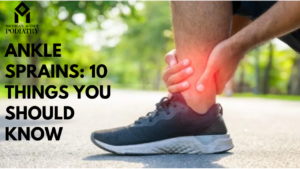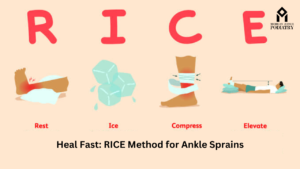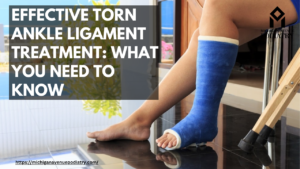Ankle sprains are among the most common injuries, affecting athletes, fitness enthusiasts, and even those with a less active lifestyle. A sudden twist or turn can overstretch or tear the ligaments that support the ankle, leading to pain, swelling, and reduced mobility. While ankle sprains are often minor, improper treatment can prolong recovery and increase the risk of chronic instability. In this article, we will discuss professional and effective treatment tips to ensure a swift and complete recovery from an ankle sprain.
Understanding Ankle Sprains
An ankle sprain occurs when the ligaments, which are the strong bands of tissue connecting bones, are stretched beyond their normal range of motion. This injury typically happens when the foot rolls inward or outward, causing the ligaments to overstretch or tear. Ankle sprains are classified into three grades:
- Grade I (Mild): Involves slight stretching and microscopic tears in the ligament fibers. Symptoms include mild pain and swelling.
- Grade II (Moderate): Involves partial tearing of the ligament. Symptoms include moderate pain, swelling, and bruising, along with some loss of mobility.
- Grade III (Severe): Involves a complete tear of the ligament. Symptoms include severe pain, swelling, bruising, and significant instability of the ankle.
Immediate Treatment: The R.I.C.E. Method
Immediate treatment of an ankle sprain is crucial for minimizing damage and accelerating recovery. The R.I.C.E. method (Rest, Ice, Compression, Elevation) is a standard first-aid treatment for ankle sprains:
- Rest: Avoid putting weight on the injured ankle. Use crutches if necessary to prevent further damage.
- Ice: Apply an ice pack to the injured area for 15-20 minutes every 2-3 hours during the first 48 hours. Ice helps reduce swelling and numb the pain.
- Compression: Wrap the ankle with an elastic bandage to provide support and reduce swelling. Ensure the wrap is snug but not too tight to avoid cutting off circulation.
- Elevation: Keep the injured ankle elevated above the level of the heart whenever possible. Elevation helps reduce swelling by allowing fluids to drain away from the injured area.
Pain Management
Managing pain effectively is essential for recovery. Over-the-counter pain relievers, such as ibuprofen or acetaminophen, can help reduce pain and inflammation. Always follow the recommended dosage and consult with a healthcare professional if you have any concerns or pre-existing conditions.
Seeking Professional Help
While mild sprains can often be managed at home, moderate to severe sprains require medical attention. A healthcare professional, such as a podiatrist or orthopedic specialist, can assess the severity of the injury and recommend appropriate treatment. Diagnostic imaging, such as X-rays or MRI scans, may be necessary to rule out fractures or other complications.
Rehabilitation and Physical Therapy
Rehabilitation plays a crucial role in the recovery process. Physical therapy helps restore strength, flexibility, and balance to the injured ankle, reducing the risk of future sprains. Here are some key components of ankle sprain rehabilitation:
- Range of Motion Exercises: Gentle exercises to restore the ankle’s range of motion are essential in the early stages of recovery. Simple movements, such as ankle circles and alphabet exercises, can help maintain flexibility.
- Strengthening Exercises: As the pain and swelling decrease, strengthening exercises can be introduced. Resistance bands and bodyweight exercises, such as calf raises and toe-heel walks, help rebuild strength in the ankle and surrounding muscles.
- Balance and Proprioception Training: Improving balance and proprioception (awareness of body position) is critical for preventing future sprains. Balance exercises, such as standing on one leg or using a balance board, enhance stability and coordination.
- Gradual Return to Activity: Gradually reintroducing weight-bearing activities and sports-specific drills is vital for a safe return to regular activities. Follow your healthcare provider’s guidance to avoid re-injury.
Read More:
Supportive Measures
In addition to physical therapy, several supportive measures can aid in the recovery process:
- Ankle Braces and Supports: Wearing an ankle brace or support can provide additional stability and prevent further injury during the recovery phase. Choose a brace that offers adequate support without restricting movement.
- Proper Footwear: Wearing appropriate footwear with good arch support and cushioning can help protect the injured ankle and prevent future sprains. Avoid high heels and shoes with inadequate support.
- Hydration and Nutrition: Staying hydrated and maintaining a balanced diet rich in vitamins and minerals can support the healing process. Nutrients such as vitamin C, zinc, and protein are essential for tissue repair and recovery.
Prevention Tips
Preventing ankle sprains in the future involves a combination of strength training, flexibility exercises, and proper footwear. Here are some tips to help reduce the risk of ankle sprains:
- Warm-Up and Stretch: Always warm up before engaging in physical activity and perform stretching exercises to maintain flexibility in the ankles and lower legs.
- Strength Training: Incorporate strength training exercises for the lower body, focusing on the muscles around the ankle joint. Strong muscles provide better support and stability.
- Balance and Coordination: Regularly practice balance and coordination exercises to improve proprioception and reduce the risk of falls and sprains.
- Proper Footwear: Wear shoes that are appropriate for your activity and provide adequate support. Replace worn-out shoes to ensure they offer the necessary protection.
- Mind Your Environment: Be mindful of your surroundings and avoid uneven or slippery surfaces that could increase the risk of an ankle sprain.
When to Resume Physical Activities
Returning to physical activities too soon can increase the risk of re-injury. It is crucial to follow your healthcare provider’s recommendations and ensure that your ankle is fully healed before resuming strenuous activities. Gradually reintroduce activities and sports-specific drills, paying close attention to any signs of discomfort or instability.
Conclusion: Taking Charge of Your Recovery
Recovering from an ankle sprain requires a combination of immediate care, professional treatment, and a structured rehabilitation program. By following the R.I.C.E. method, seeking appropriate medical attention, and committing to physical therapy, you can achieve a swift and complete recovery. Remember to take preventive measures to reduce the risk of future sprains and maintain overall foot health. Taking charge of your recovery ensures that you can return to your regular activities with confidence and stability.




